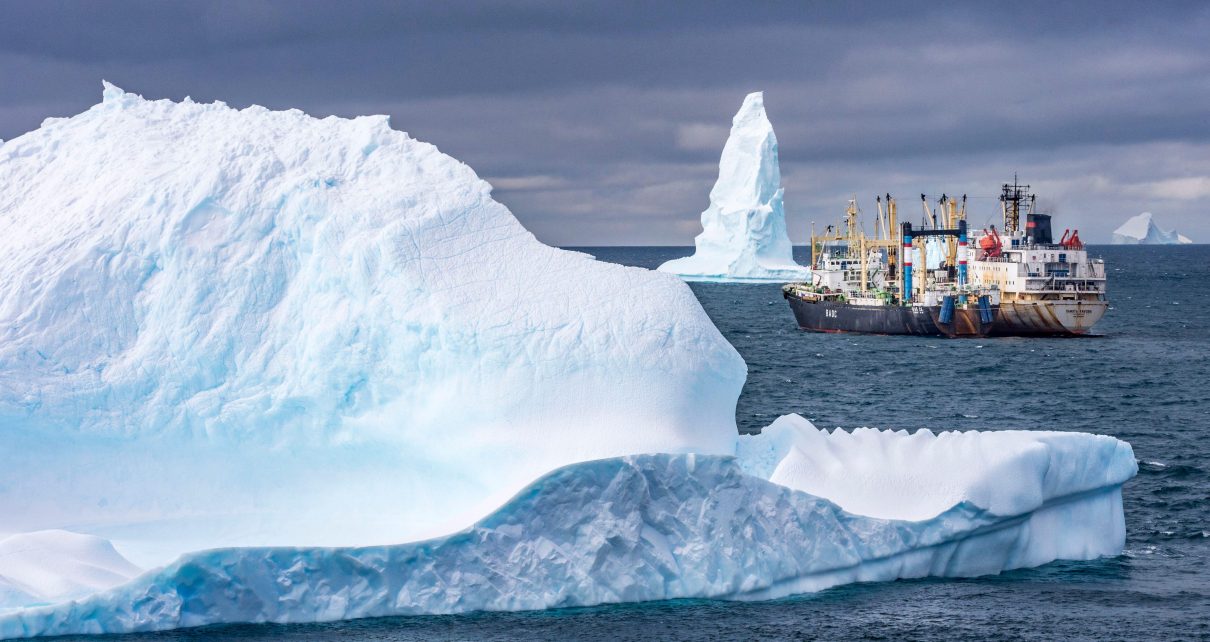The icy ocean around Antarctica may seem like a cold and foreboding place. But it’s actually brimming with life.
Penguins and seals build their colonies on its rocky shores. Orcas, whales and a variety of fish zip through its gray waters. Seabirds glide overhead.
The Antarctic Peninsula, the continent’s northernmost spit of land, is one of the most biologically diverse regions of all. And at the cornerstone of its delicate ecosystem is a small, shrimp-like creature known as the Antarctic krill.
“Krill is literally the keystone species in the Southern Ocean,” said Cassandra Brooks, an environmental scientist at the University of Colorado, Boulder. “Literally so many things feed on it. The whales feed on it, and whales come from all over to feed on it. The penguins feed on it, the seabirds, the fish, the seals. So it is such a critical part of the food system in the Southern Ocean.”
No more than a few inches long, krill are some of the most abundant organisms on the planet—at least, for now. But some scientists worry about their future.
Krill fishing is a lucrative industry, and one that’s steadily on the rise. Krill catch has nearly tripled since the 1980s. Fishers landed around 400,000 metric tons of krill in 2019 alone, the majority of it caught from the rich waters around the Antarctic Peninsula.
At the same time, scientists worry that climate change on the peninsula could cause krill populations to decline or migrate into different, and perhaps more heavily fished, areas within the next few decades.
The double whammy of warming and increased fishing could be disastrous both for krill and for the animals that depend on them, some researchers say.
This week, 26 nations are meeting to discuss a proposal that could ease these effects.
A virtual meeting of the Commission for the Conservation of Antarctic Marine Living Resources (CCAMLR) is convening between now and Oct. 30. Established in 1982 as part of the Antarctic Treaty System, the commission’s aim is to conserve Antarctic marine life and sustainably manage the region’s fisheries.
The commission has the power to implement marine protected areas, or MPAs, if all its members agree by consensus. So far, there are just two in existence—one around the South Orkney Islands, just north of the Antarctic Peninsula, and another covering 600,000 square miles in the Ross Sea.
But several others have been proposed. These include one protected area off the coast of East Antarctica and another in the Weddell Sea.
A third proposal calls for a marine protected area around the Antarctic Peninsula. The proposal would prohibit fishing in certain biologically rich areas, while allowing for sustainable, managed fisheries in other regions.
“The challenge is to find a proposal, an MPA proposal, that can protect the ecosystem at the same time that takes into consideration the interests of different members or different activities,” said Mecha Santos, an Argentinean scientist who helped develop the MPA proposal. “We need to take into consideration that this is an area that is important for many countries for different reasons.”
The proposal has garnered widespread support from scientists. Researchers say it could protect krill populations from overfishing—all the more important at a time when the future effects of climate change are a potential threat to the peninsula’s diverse ecosystem.
Earlier this month, nine scientists (including Brooks, the CU Boulder scientist) published a comment in the journal Nature urging commission members to adopt the MPA.
The Antarctic Peninsula is a heavily trafficked region, touched by the fingerprint of human activities in a variety of ways, the authors noted. On top of fishing and climate change, tourism and research expeditions also have the potential to disrupt the ecosystem.
“This delicate and iconic ecosystem is in peril,” the authors wrote.
The threat of future warming
For much of the 20th century, the Antarctic Peninsula was one of the fastest warming regions on the planet. Research suggests that temperatures there rose by nearly 1 degree Fahrenheit each decade for at least 50 years.
Then, in the late 1990s, a strange new trend emerged. Temperatures on the peninsula began to drop slightly.
Studies suggest that the cooling pattern is probably driven by a combination of natural climate cycles and atmospheric changes related to the healing of the so-called ozone hole. Thanks to a monumental international effort to cut down on the use of ozone-depleting chemicals, ozone—a substance in the atmosphere that helps protect the Earth from harmful ultraviolet rays—is recovering.
As ozone has built back up in the atmosphere, though, it has caused some changes in winds and other atmospheric circulation patterns in the Southern Hemisphere. And some of these changes have contributed to a dip in local temperatures.
But that pattern isn’t expected to last, scientists warn.
In the first place, the cooling trend is modest—temperatures on the peninsula are still substantially higher than they were in the preindustrial era. And as greenhouse gas emissions continue pouring into the atmosphere, the influence of climate change will eventually outweigh the temporary cooling effect.
It’s likely only a matter of time before the long-term warming trend around the Antarctic Peninsula resumes. The region has seen some record-breaking hot days in the past year.
In February—midsummer in the Southern Hemisphere—a weather station on the Antarctic Peninsula recorded temperatures topping 64 degrees Fahrenheit, a record for the continent. Just a few days later, instruments on Seymour Island, off the peninsula’s northern reaches, recorded temperatures above 69 degrees.
Scientists are still studying the ways that rising temperatures could affect krill populations. It’s a complex question with a lot of uncertainty.
Juvenile krill, known as krill larvae, are thought to use sea ice as a habitat. It helps them hide from predators and take refuge from strong Antarctic ocean currents.
“A lot of work we’ve done over the last couple years is trying to understand the winter sea ice extent and understand what it is about the sea ice that krill are using,” said Stuart Corney, an expert on Antarctic ecosystems at the University of Tasmania.
Antarctic sea ice has been rapidly declining for the last five or six years, and that will likely continue as the region keeps warming.
In the short term, it’s possible krill could benefit in some regions. Juvenile krill tend to favor rough, uneven ice, according to Corney. And some research suggests that this kind of ice habitat may increase around Antarctica—at least temporarily—even as total ice coverage declines.
But as sea ice continues to disappear over time, the favored habitats will start to vanish, as well. That’s bad news for krill in the long run.
Other research suggests that rising temperatures could inhibit krill growth, according to Emily Klein, a scientist at Boston University. In other words, krill may get smaller over time.
That means if the total number of krill stays constant, predators will need to eat more of them to survive. And fishers will need to catch more of them to meet their weight quotas.
Some scientists also worry that as the waters warm and sea ice declines, krill may start migrating into different regions of the Southern Ocean. If they move into areas where fishing is more intense, their populations could decline faster.
So far, it’s a bit unclear exactly how krill populations will respond in the coming decades. But modeling studies suggest that in the long run, it’s likely that krill populations will be negatively affected by climate change. And if krill decline, so will the predators that feed on them.
This kind of chain reaction could profoundly alter the Antarctic ecosystem.
“I think what we’ll see [in the future] is worsening of the same trends that are happening in the Antarctic Peninsula right now,” said Andrea Kavanagh, director of Antarctic and Southern Ocean conservation work at the Pew Charitable Trusts, which is advocating for additional Southern Ocean MPAs. “You’ll see more declines in penguin populations; you’ll see less sea ice, warmer waters.”
It’s true that marine protected areas can’t protect against the influence of climate change.
“The only thing that can stop climate change is reducing fossil fuel use,” Kavanagh noted. “But what MPAs can do is it stops fishing. And stopping fishing in certain areas gives the ecosystem resilience to the changing climate, so they’re better able to adapt to warming.”
This isn’t the first year a marine protected area has been on the table for the peninsula. The proposal has been submitted—and failed to pass—twice in a row now.
This year will mark the third year the proposal has been up for discussion. It was first developed and submitted by member states Chile and Argentina, and currently has support from a number of other members.
Years of discussion aren’t uncommon. The Ross Sea MPA, established in 2016, took five years of negotiations to finally pass. With 26 member states required to reach a consensus, and lucrative commercial fishing interests at stake, the commission’s proceedings tend to be complex.
Still, recent studies have suggested that the MPA doesn’t necessarily have to come at the expense of the fishing industry.
Research co-authored by Klein, the Boston University scientist, suggests that an MPA around the Antarctic Peninsula could help bolster krill populations in the coming decades, even when accounting for the influence of climate change. And it could do so without dramatically affecting the fishing industry.
“The fisheries can do OK, too,” Klein told E&E News. “We didn’t see huge declines in the potential for krill catches. That was really heartening.”
The pandemic has made 2020 a difficult year to continue the negotiations, noted Santos, the Argentinean scientist who helped develop the proposal. Because the meetings are virtual this year, “that means it is very complicated to have bilateral conversations with countries that may have still some concerns,” she said in an interview.
“But I am always with hope the MPA—this MPA and the other MPAs—could be adopted,” she added. “I think we are seeing that the world is changing, it’s facing the habitat destruction, so I think that … we need to have these big conservation actions that help us to restore the ecosystem, or to protect them—now and for the future.”
Reprinted from Climatewire with permission from E&E News. E&E provides daily coverage of essential energy and environmental news at www.eenews.net.



